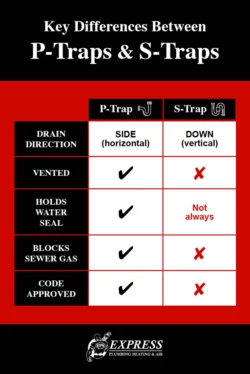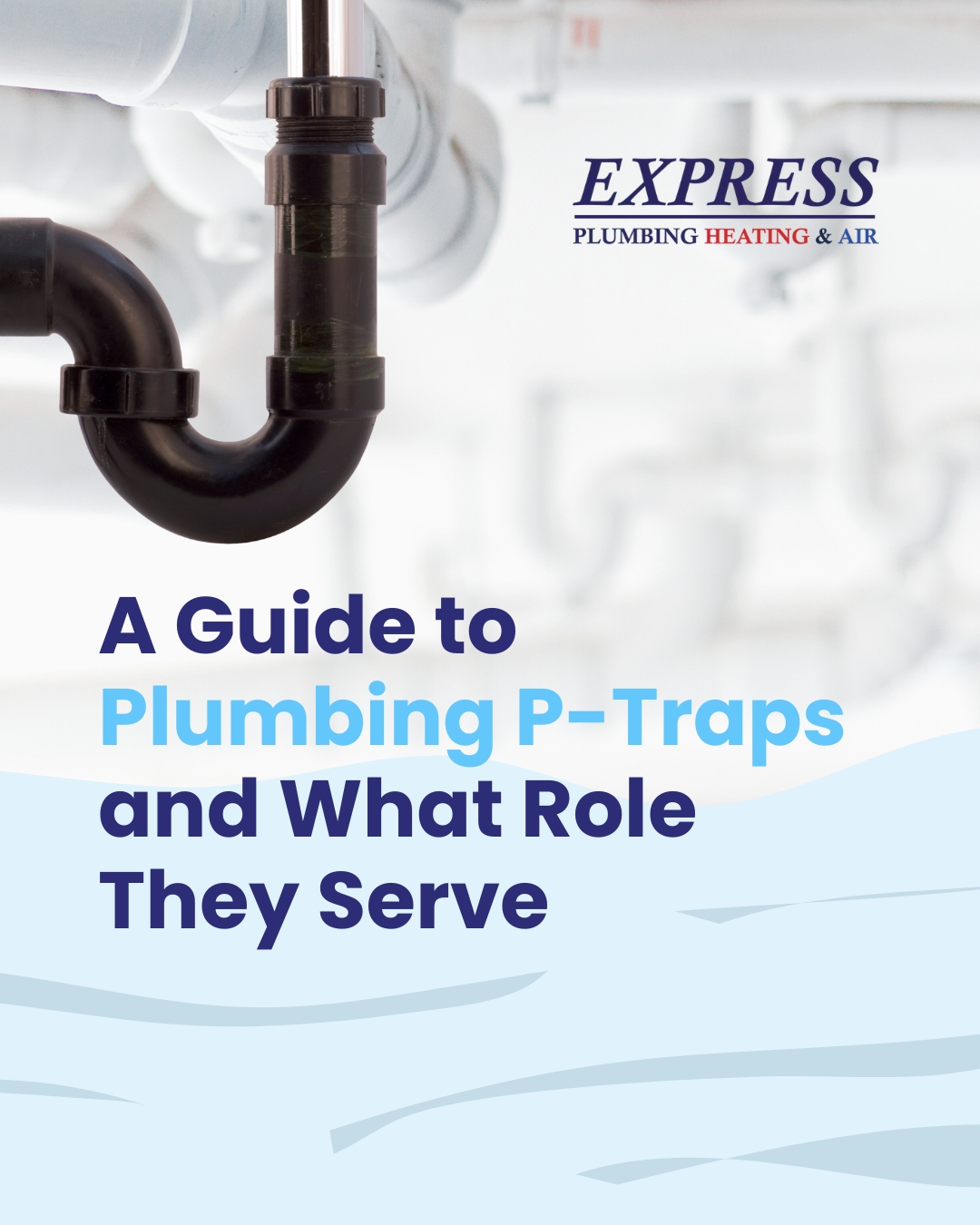P-traps are fundamental components in every home’s plumbing system. In this plumbing P-trap guide, you’ll learn what these curved pipes do, why they’re necessary, and how to maintain them properly. At Express Plumbing Heating & Air, our service area covers Boise, Nampa, Caldwell, and other surrounding areas in Idaho. Whether you need help with your P-traps or any other part of your plumbing system, we’re here to help.
Understanding P-Traps in Plumbing
Starting with a basic understanding of P-traps will help you appreciate their role in keeping your home safe and comfortable.
What is a P-trap in plumbing?
A P-trap in plumbing is a curved section of pipe installed beneath sinks, tubs, floor drains, and other similar fixtures. Named for its distinctive “P” shape, this pipe segment is a water seal between your home and the public sewer system. P-traps are mandatory in residential and commercial plumbing across the United States.
How does a P-trap work?
When water flows down your drain, like from your shower or dishwasher, a small amount remains in the curved portion of the P-trap. This creates a water seal that blocks toxic sewer gases from rising through the drain and entering your home.
Vents allow air to enter the drain system, maintaining atmospheric pressure and facilitating smooth water flow. Without proper air venting, the water seal in a P-trap could be siphoned away, rendering the trap ineffective.
Why are P-traps required in plumbing?
The main purpose of a P-trap is to prevent harmful and unpleasant sewer gases from entering your home. P-traps also catch valuable items, like jewelry, that may accidentally fall down the drain and debris that might otherwise cause a main sewer line clog. P-traps are also advantageous as convenient access points for basic drain cleaning services.
Building codes nationwide require P-traps on all plumbing fixtures connected to the sewer system. This is for both health and safety reasons. Sewer gases can contain methane, hydrogen sulfide, and other harmful substances.
Types of P-Traps and Their Applications
P-traps are available in various materials and configurations to suit different needs.
Different materials used for P-traps
The majority of P-traps are made with one of three main types of materials:
- PVC: Most common in modern homes, PVC P-traps are lightweight, affordable, and resistant to corrosion.
- Chrome and metal: Offering aesthetic appeal in areas where plumbing is visible, chrome or metal P-traps are more durable and come at a higher cost than PVC.
- Brass and copper: Used in high-end applications, brass and copper P-traps are a premium choice with exceptional durability and a distinctive appearance.
P-trap vs. S-trap: What’s the difference?
While P-traps create a horizontal outlet that connects to a vented drain system, outdated S-traps continue to curve downward. Modern plumbing codes no longer permit S-traps because they’re prone to siphoning. When siphoning occurs, the water seal is no longer effective at preventing sewer gases from entering the home. P-traps can maintain their water seal by properly venting in the drain system. This venting prevents the vacuum effect that can pull water from the trap, as can be the case with S-trap.
Common fixtures that require P-traps
All plumbing fixtures that connect to your drainage system require P-traps, including:
- Bathroom sinks and vanities
- Kitchen sinks and garbage disposals
- Utility and laundry sinks
- Bathtubs and showers
- Overflow drains in bathtubs
- Floor drains in basements, laundry rooms, and garages
- Washing machines
- Dishwasher drains
Installing and Maintaining a P-Trap
Proper P-trap installation and maintenance can prevent costly plumbing repairs down the line.
How to install a P-trap under a sink
Installing a P-trap requires basic tools and careful attention to proper alignment. You’ll need an adjustable wrench, channel-lock pliers, Teflon tape or pipe joint compound, and a bucket to catch water.
To connect a P-trap to a drain pipe:
- Step one: Position the horizontal trap arm to align with the drain pipe in the wall.
- Step two: Connect the curved J-bend to the tailpipe extending from the sink.
- Step three: Hand-tighten the slip nuts and finish with a quarter turn using pliers.
- Step four: Check for leaks by running water and inspecting all connections.
Proper alignment is key to preventing leaks and drainage issues. The P-trap should form a smooth path for water to flow without creating areas where debris can collect.
How to clean and maintain a P-trap
For households with normal use, cleaning P-traps yearly is usually sufficient. However, if you notice signs of a clogged or malfunctioning P-trap, such as slow draining, unpleasant odors, or gurgling sounds when the water drains, you should consider cleaning more frequently.
To remove, clean, and reinstall a P-trap:
- Step one: Place a bucket beneath the P-trap to catch water.
- Step two: Loosen the slip nuts on both ends of the curved section.
- Step three: Remove the P-trap and empty its contents into the bucket.
- Step four: Clean the trap with mild soap and a brush.
- Step five: Rinse the P-trap thoroughly.
- Step six: Reinstall the trap, firmly tightening connections without overtightening.
Common P-trap problems and how to fix them
When you notice minor issues with a P-trap, it’s important to address them quickly before they escalate into larger problems. If unsure, call a professional for a more thorough plumbing service inspection.
Common P-trap problems include:
- Leaks at connection points: Solutions may involve tightening loose connections, replacing worn washers, or replacing the P-trap assembly completely.
- Bad odors from the sink: To prevent drying out in rarely used sinks, which allows sewer gases to escape, simply run water for 30 seconds to refill the trap.
- Slow drainage: A partially clogged P-trap can lead to slow drainage, which you can address by cleaning the trap or booking a professional drain-cleaning service if the clog is further down the line.
Final Thoughts – The Importance of a Properly Functioning P-Trap
Though often overlooked, P-traps are vital to your home’s plumbing system. Their simple design has remained unchanged for decades because they work reliably to protect your home from sewer gases.
If you encounter persistent leaks, recurring clogs, or unusual odors, they may indicate deeper plumbing issues. Contact Express Plumbing Heating & Air immediately for complete P-trap installation and maintenance. We offer plumbing and HVAC solutions to homeowners in Boise, Caldwell, and surrounding Idaho communities.




